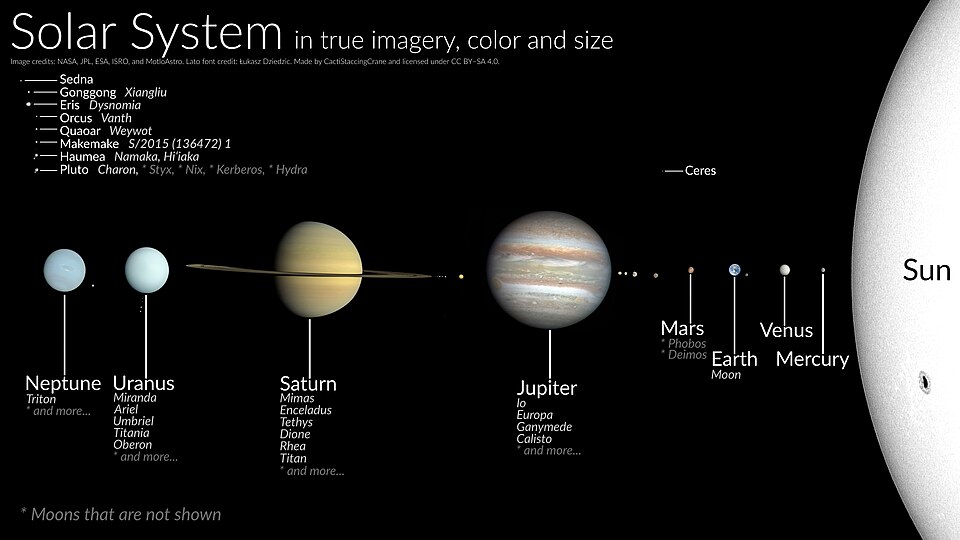
Where could life in the solar system be? Life in the solar system, if there is any, could be on the moons Europa, Titan, Enceladus, and the surface of Mars.
We don’t know what life on other planets would need to survive. All we can say is what life on our planet needs to survive, and assume that it would be the same on other planets. So, when we ask the question, “Where could life in the solar system be?”, we are basically asking where in the solar system life we currently have on Earth could survive. There might be types of life that can survive and even thrive in the depths of Jupiter, or on the flame-grilled surface of Venus; we have just never heard of them. We can only ever know what is here on Earth, though, so when we search for life, we have to search for the life that we know.
When we look for life, we assume that it needs chemical elements (most commonly carbon on Earth, but others would do), a source of energy with which to do work, and a fluid to make chemical reactions possible (we assume water, but it doesn’t have to be). If a celestial body has these three things, we believe that there is the possibility for life.
Most of the planets in the solar system are already written off because they are too hot, or too dry, or too gassy, or they have too much pressure. I understand that there is life that exists in very difficult circumstances, even here on Earth, but the environment does have to allow for chemical reactions to take place. So, where in the solar system should astronomers look for life?
The surface of Mars is a good place to start looking, although there is a strong possibility that Mars had life in the past but doesn’t have life anymore. The surface of Mars is extremely cold, and there is a very low atmospheric pressure, so there is no liquid water on the surface. There is some frozen water, but it really needs to be liquid. Mars did have liquid water in the past, which is why experts think that there might have been life there once. In fact, one of the theories for how life started here on Earth is that it was seeded by meteors that were blasted off the surface of Mars. There could be life under the ice caps or in underground lakes, but the chances are fairly slim.
Europa, one of Jupiter’s moons, is a better bet than Mars. The moon is covered in very hard ice. Jupiter is far from the sun, and not much heat reaches Europa. As ice gets colder, it gets harder, and it is unlikely that there will be any life on the surface. However, Europa is pulled very strongly by the gravity of Jupiter, and that deforms it, heating up the center of the planet. That heat melts the water under the ice, and it is thought that Europa has more liquid water than all of Earth. There may be minerals and salts in that water as well from rocks at the core of the planet. If that is the case, there could very well be life there.
Enceladus is a moon of Saturn, and it is almost exactly the same as Europa. It has a thick layer of ice, and the tidal forces from Saturn deform it, and the heat melts the lower layers of ice. There are salts and minerals in that water as well. Both of these moons could have life, but it is very hard to get there and find it. Enceladus is a little easier to check because the liquid water jets out of the ice sheets in some places. NASA sent a probe through the clouds of water, and they detected a lot of organic materials, but no life.
And finally, there is the surface of Titan. Titan is a little different because it doesn’t have any water. A liquid is necessary for chemical reactions to take place, but that doesn’t always have to be water. Titan has rivers, lakes, and oceans of liquid methane. It even rains liquid methane. It has to be very cold for methane to become a liquid, and the surface of Titan is -182.5 ℃, which is cold enough. Life as we know it probably couldn’t exist on Titan, but that doesn’t mean that life as we don’t know does. There are carbon-rich compounds called tholins, and there is liquid methane. It is possible that life could start here. It will be difficult to find, though. And this is what I learned today.
Sources
https://www.planetary.org/articles/the-best-places-to-search-for-life-in-our-solar-system
https://evolution.berkeley.edu/a-place-for-life/ingredients-for-life/requirements-for-life
Image By CactiStaccingCrane – Own work, CC BY-SA 4.0, https://commons.wikimedia.org/w/index.php?curid=117066753
